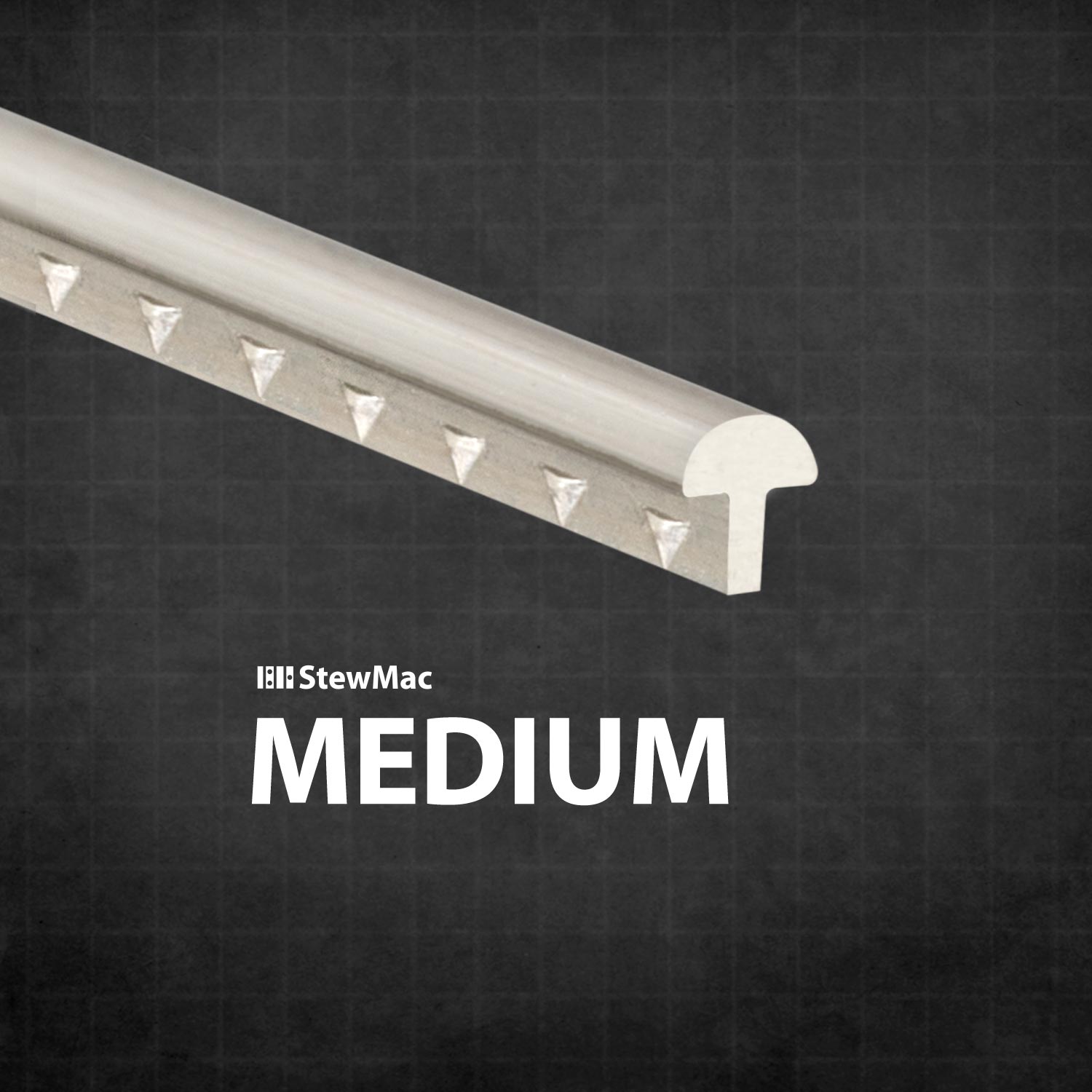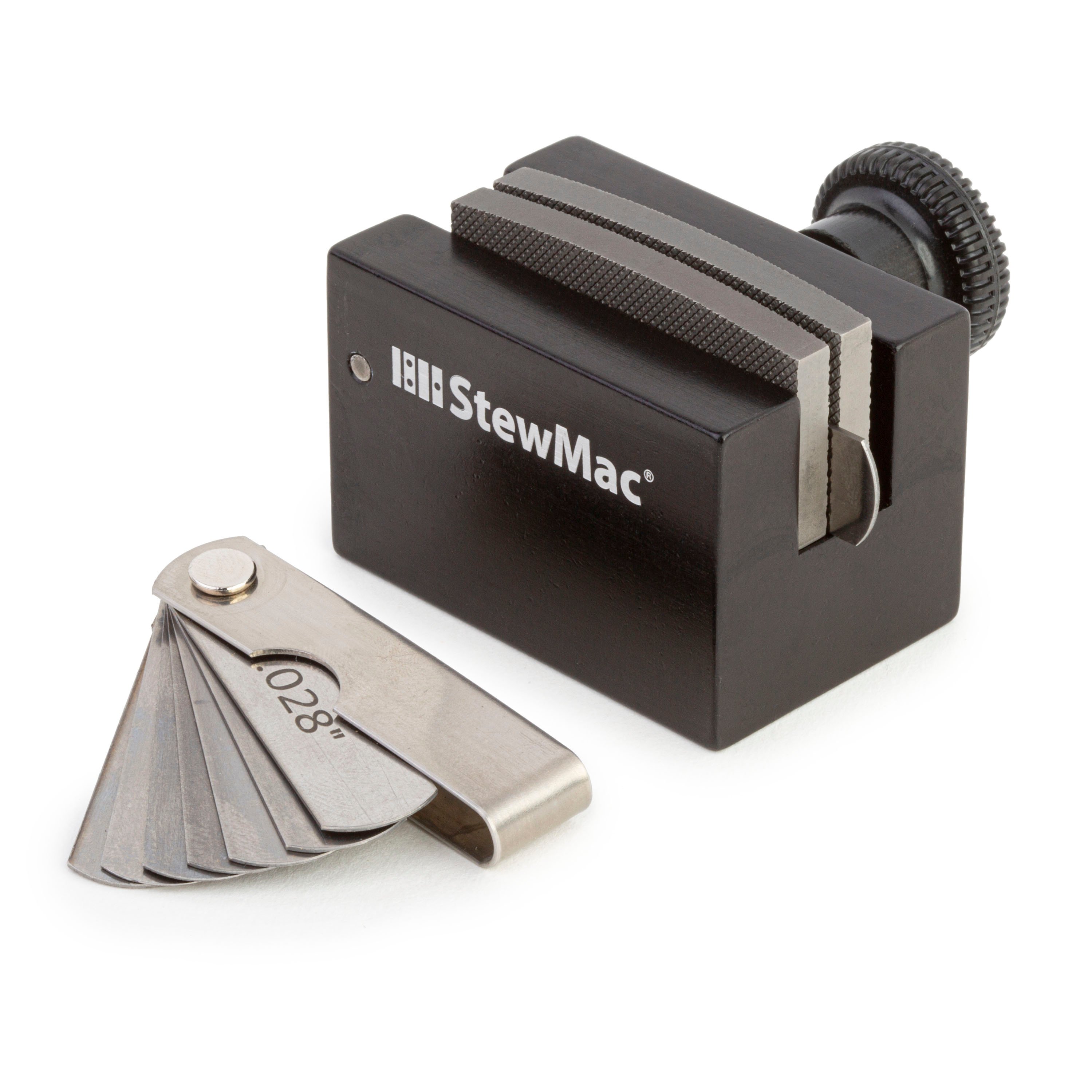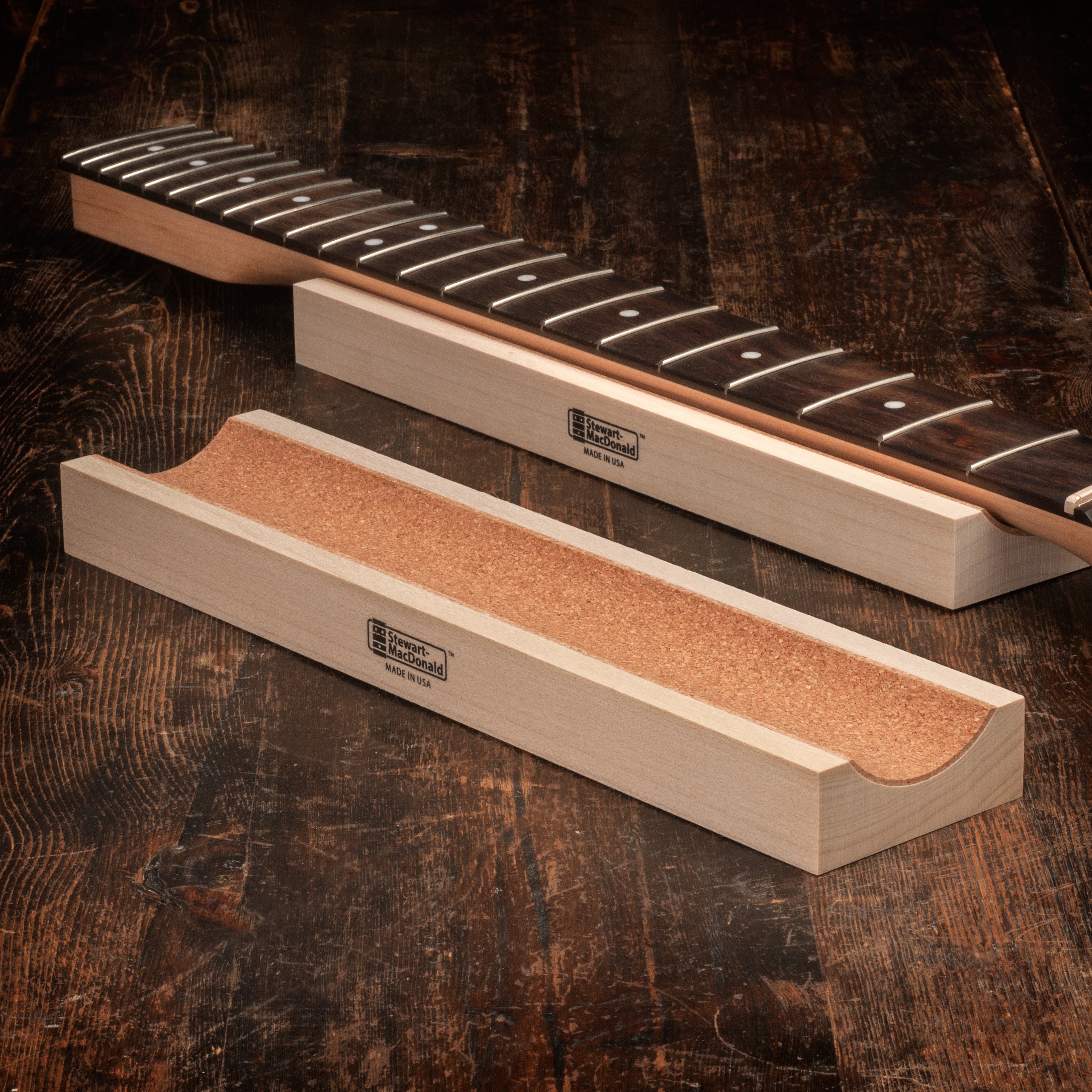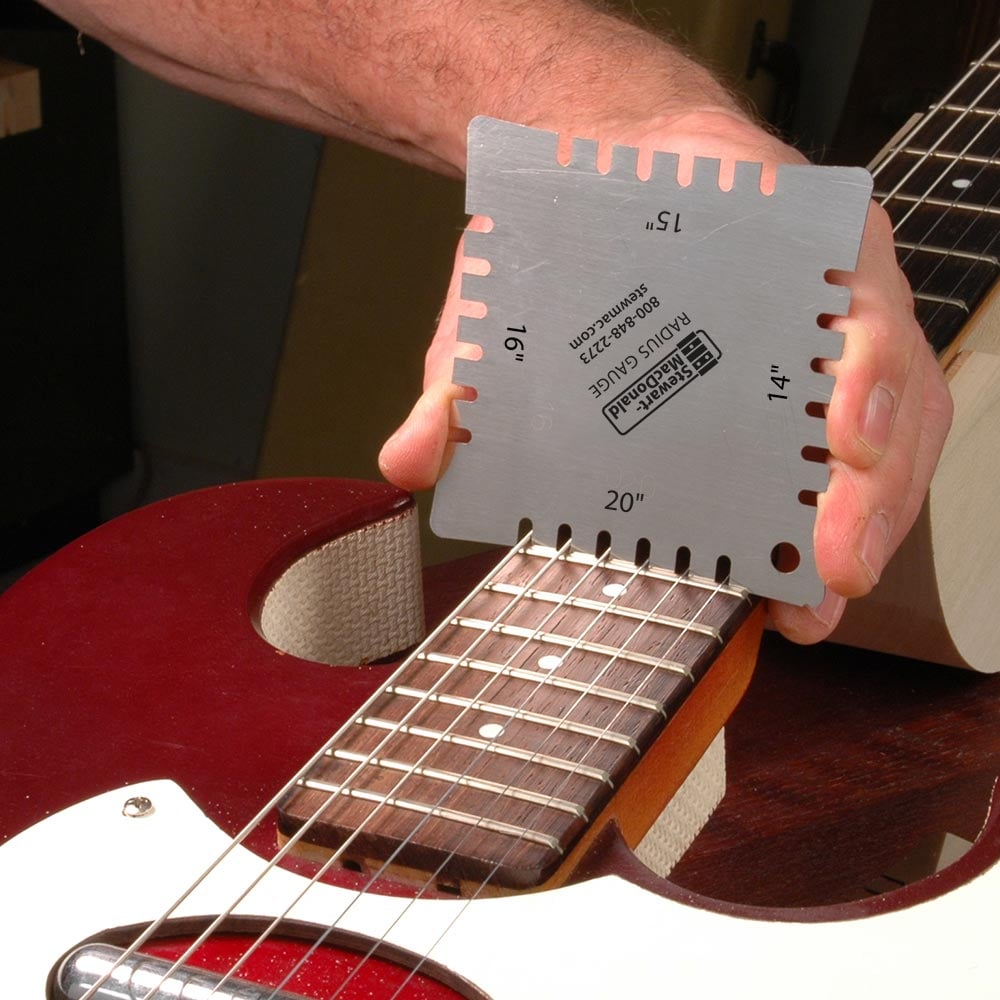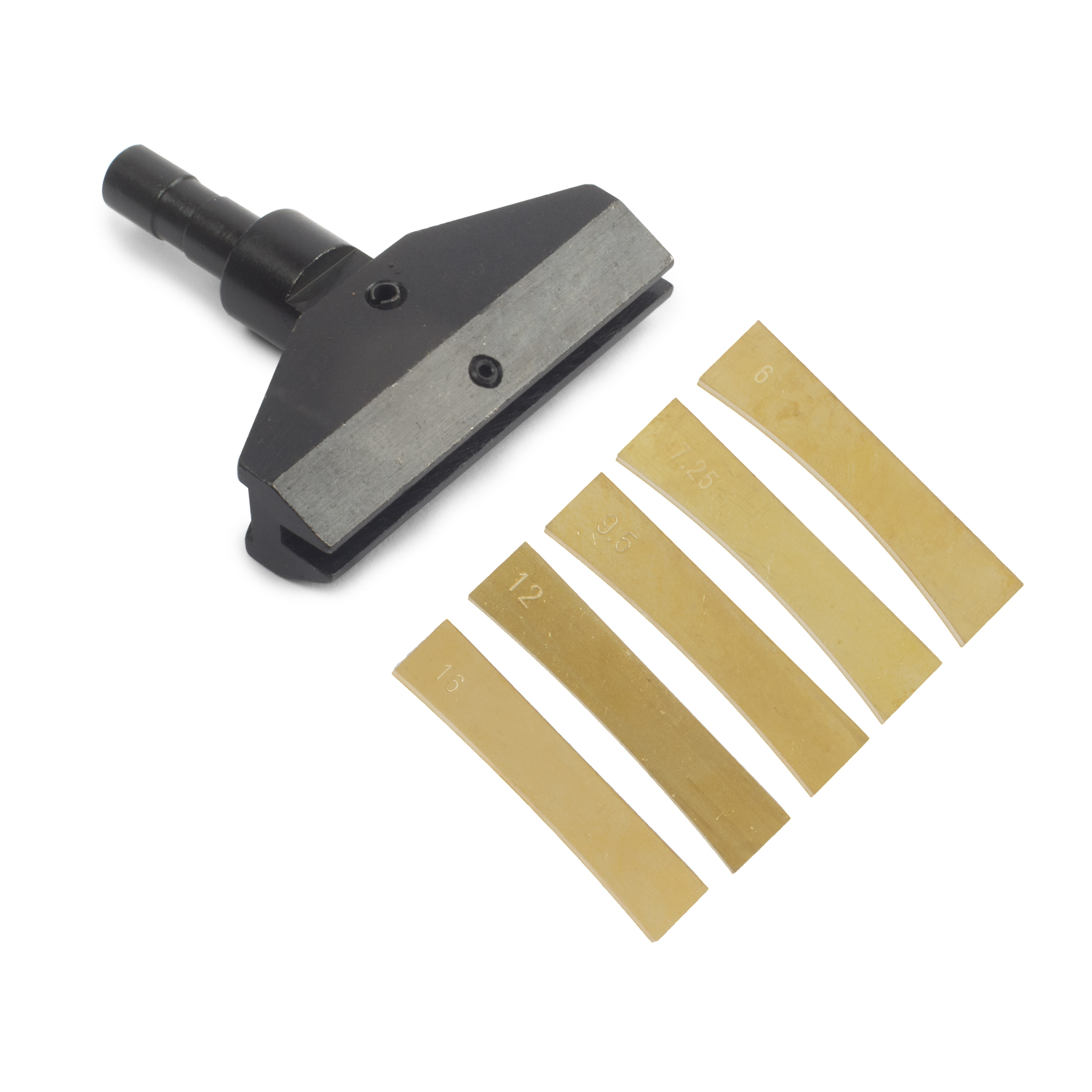Refretting the Mike Bloomfield Tele
Issue 260 April 21, 2016
Dan Erlewine just moved into a new shop! In this video he finishes work on the Mike Bloomfield Telecaster, a guitar with a lot of history. We’ve been following this guitar for several videos; now Dan wraps it up with an assist from Erick Coleman.
About the guitar in this video: This is the 1963 Tele that Mike Bloomfield played on Bob Dylan's "Highway 61 Revisited" and on the first Paul Butterfield Blues Band album in the 1960s.
- The fretboard radius changes up and down this neck!
- Modified version of Leo Fender's sideways fretting technique
- Special neck holder for this sideways fretting.
- Erick Coleman and Dan work as a tag team on this complex refret.
Video Transcription
[on-screen text reads: Stewart-MacDonald - Trade Secrets! Refretting the Bloomfield Tele. Dan Erlewine - Guiar Repairman, Author]
Dan Erlewine: If you've watched a lot of Trade Secrets videos, you might see that I'm in a new shop. This is my new shop. It's bigger than the old one. We had it built this year. It's brand new and I'm just moving in. But if you stick around for a while, I'll mess it up for you just like I did the old one.
Today we're going to refret the Mike Bloomfield Telecaster. If you've been watching Trade Secrets lately, you've seen us pull the frets on this old 63 neck, clean the slots of tons of glue, and fix all the chips in it before fretting it. Today we're finally ready to fret it. This is the guitar that took me into playing blues. I heard Mike Bloomfield play it in 1963 in the fall at the Michigan Union in Ann Arbor, Michigan where I lived. He was with Nick Gravenites and the Mike Bloomfield rhythm and blues band. My friend Jay Edwards and I from our band went and heard it and it knocked us out. This is also the guitar that turned me on to B.B. King because Bloomfield's up there on the stage saying, "Man, if you dig this stuff, man, you got to listen to B.B. King, man, because he's the greatest man." That's how Bloomfield talked. Always really excited and he's always saying man this and man that.
Sideways fretting technique
Back in the days, fender used a foot operated cable to pull this fixture with the fret loaded into it across the board, and the fret actually broached its way into the slot. The ends were sharpened on a little machine that I've never seen. By broaching, that means that the barbs on the tang were cutting sideways. So you couldn't pull the fret out. It was under the surface and that kept the ends down. Leo hated ends that popped up. On my version, I'm using a drill press and a Fretting Caul, and I put the fret in a little bit off center. It's not quite all the way across the fretboard. I'll press it down in. Then I take a punch and a hammer and tap it sideways until it locks in, and those fret ends won't pop up just like Leo's.
Special neck holder for sideways fretting
This is my sideways fretting contraption. I've made a number of these over the years and this is the best one yet. In short, I have a piece of MDF board with holes in the bottom for the mounting screws of the neck. The heel goes here, peghead goes here, and this holds it down. This is a StewMac neck rest [on-screen text reads: StewMac Neck Support Caul - stewmac.com] cut short and drilled in tap for Allen screws so I can raise and lower it. Some necks are fat and thick, some aren't. This way, I'm always supporting.
This fence slides in these grooves in the table, and it lets me ride my caul back and forth underneath the quill. This is a little lockdown. It fits in that groove, so when I do my tap, it doesn't want to tip. Okay. I've got this here in the jig now and I'm about ready to fret, but the fret wire needs a little prep. My buddy Erick Coleman's going to take care of that, so we're going to tag team this job.
[on-screen text reads: Erick Coleman, Guitar Repairman]
Prep the fret wire to fit the neck
Erick Coleman: When choosing fret wire for this job, there was a few things that we needed to take into consideration. First off, it's the very thin fender round laminate style that they used during this era. It doesn't have a lot of material to take off anyway when you're doing a refret. Plus, it's already been refretted one time, at least, so the finger board's got some flats and some inconsistencies along it. What we're going to do is use Stewart-MacDonald's 155 Wire, which has a taller crown. We're going to level out any weird inconsistencies in the fingerboard out of the frets when we do that. It's generally just a good idea not to level in on a vintage board like this. It can change the look of it and the feel of the guitar in general, and it's just something that we don't like to see or do.
The other thing I need to think about is the fret barbs. These slots on these old fenders are pretty tight. So if I was to jam in a full size piece of fret wire [on-screen text reads: Oversize frets can cause backbow], it could push the neck into a back bow that couldn't be adjusted out with the truss rod. I'm going to have to reduce the size of the barbs in order to get this fret wire to fit that neck. I'm going down the neck with a variety of different Feeler Gauges just to see what fits. This will help me determine how much of the barbs I'm going to remove off the fret wire. For that job, I like to use the Fret Barber. The fret barber uses feeler gauges as stops to determine how much material you're going to be taking off the barbs. The smaller the feeler gauge, the more you're going to reduce the overall size.
I'm starting with a 32 thousandths gauge and I'm working my way down at 2 thousandths of an inch intervals [on-screen text reads: StewMac #0155 Medium Fretwire - stewmac.com]. If you look closely, you'll notice the wire on the right has been run through the fret barber and the wire on the left hasn't been touched. It's a very slight difference, but it makes a big difference. I've brought the barbs down to where I want them. Now I'm going to bend the fret wire to match the fretboard radius.
Bend the fret wire to match the fretboard radius
Dan Erlewine: We have a six inch radius at the end. A lot of little nines in here. It starts to get flat right there. Those shiny spots are flats.
[on-screen text reads: Uneven fretboard radius: Dan will use tall fretwire, then level the frets to make them uniform]
Erick Coleman: Yeah, you can see it's been kind of changed to about a nine here [Erick sets the StewMac Radius Gauge on the fretboard]. As I work my way down, it starts to get tighter and tighter.
Dan Erlewine: And it's really rolling off on that edge, isn't it?
Erick Coleman: Right. Yep. You can see it rolling off on the edge there with the gap in the light.
Dan Erlewine: Even more than the radius. It's like a radius and then a little kick down.
Erick Coleman: It's not quite a seven. You can see the flat spot in the middle, the light underneath it there.
Dan Erlewine: I see it.
Erick Coleman: It's getting closer. As we get close to the 19th fret, it looks like we're going to start by running in a seven and a quarter. I use the StewMac Fret Bender to bend pieces into seven and a quarter and nine and a half inch radii. [Erick places the radius gauge against the fret wire he just bent] Yeah, that looks good.
Dan Erlewine: I've got a six inch radius in here. I mark them because that's what you said. This was a little bit tighter than this seven.
Erick Coleman: Yeah. I've bent that piece of wire to match.
Install the frets
Dan Erlewine: Okay, let's give her a try. I'm putting these in with Fish Glue. It's one of my favorites for this kind of thing. I also use Hide Glue. This is a lot like hide glue because it drives crystalline and hard. You can dissolve it like hide glue and it's pretty safe. Get a little light on the subject. I'm taking most of it out with that Pallet Knife. I'm going to wipe it down, get that tape off there. That's when the fret goes in. Okay, now we're ready. Zero in on that slot.
That fret wire, I took a fall and sharpened a point kind of like the originals were done. It was sharpen, so when you drove it over, it cut its way. I'm a little short on this side and way long on this side, and I'm pressing it down with that to get the ends down a little bit. Then I can lock the drill press quill right there and it holds it. I can come in with a little hold down and tighten that. This hold down is a piece of the hickory floor on my new floor, so is that. I got a lot of it left over.
That gets the ends down. Now I'm going to come in with a different caul [on-screen text reads: Fret Pres Caul and Inserts - stewmac.com] and get the center. There's the 12. I can see it flattening out. A little bit of that hump in the center. Go back to that six. This is a complex fret job [on-screen text reads: Dan is going to unusual lengths to keep this historic fretboard unchanged]. I'm really trying to do everything I can to keep it vintage and do a cool job. That's pretty nice. I'm going to tighten that quill down and tap this fret. Tighten it down and let it hold there while it dries. 15 minutes maybe. Situation report is good. What I've got here is a fret in. The ends are down tight. Next one down is more of a seven and a quarter, I'd say, than the last one. Seven and a quarter, please. [Erick cuts the fret wire for Dan using a StewMac Fret Cutter] Okay, here we need a little flatter one, closer to a nine and a half. It's only flat in the center.
Erick Coleman: There you go.
Dan Erlewine: It's going quick now. Getting a feel for it. It's feeling good. Watch the mark [Dan uses a fret hammer to hammer the fret in]. It's gone. That's about a 16th of an inch. Fretting on down the line. These are going in quite well. Nice and level. I'm at the 12th fret and I've got a ways to go and it'll take me a couple hours. I'm changing fret wires as they go, different size barbs, even some of them using a solid wire that didn't go through the fret barber. So let's see how it goes.
[Erick starts playing electric guitar]
That's it. The last fret. They're all in. Since you've been gone, we finished up the fret job and it came out really great. Fret board looks old and dirty just like it started. It's got a bone nut on it and it's killer sounding. It goes out tomorrow and I'm really going to miss it. I wish Mike Bloomfield was here to play it. If he was, he'd probably play something like this. You with me, Erick?
Erick Coleman: Go for it pops.
[Dan and Erick start playing a blues song on electric guitars together]


